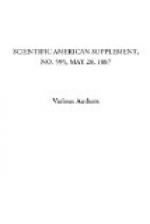Her wake was a broad smooth brown path, cut right through the rough surface of the river. On each side of this path rose and broke the angry little seas lashed up by the scourging wind. Along the very center of the brown track ran a thin ridge of sparkling foam, some 2 ft. high and some 20 ft. long, caused by the rudder being dragged through the water. There was scarcely any vibration. The noise was not excessive. A rapid whirr due to the engines, and a rythmical clatter due to the relief valve on one of the port engine cylinders not being screwed down hard enough, and therefore lifting a little in its seat at each stroke, made the most of it. The most prominent noise perhaps was the hum of the fans. Standing forward, the deck seems to slope away downward aft, as indeed it does, for it is to be noted that at these high speeds the forefoot of the boat is always thrown up clean out of the water—and the whole aspect of the boat: the funnels vomiting thin brown smoke, and occasionally, when a fire door is opened, a lurid pillar of flame for a moment; the whirr in the engine room; the dull thunder of the fans, produce an impression on the mind not easily expressed, and due in some measure no doubt to the exhilaration caused by the rapid motion through the air.
The best way to convey what we mean is to say that the whole craft seems to be alive, and a perfect demon of energy and strength. Many persons hold that a torpedo boat is likely to be more useful in terrifying an enemy than in doing him real harm, and we can safely say that the captain of an ironclad who saw half a dozen of these vessels bearing down on him, and did not wish himself well out of a scrape, has more nerve than most men.
The second mile was run in far less time than that in which what we have written concerning it can be read, and then the boat turned again, and once more the head wind with all its discomforts was encountered. Events repeated themselves, and so at last the sixth trip was completed, and the boat proceeded at a leisurely pace back again to Poplar. Mr. Crohn, representing Messrs. Yarrow on board, and all concerned, might well feel satisfied. We had traveled at a greater speed than had ever before been reached by anything that floats, and there was no hitch or impediment or trouble of any kind.




